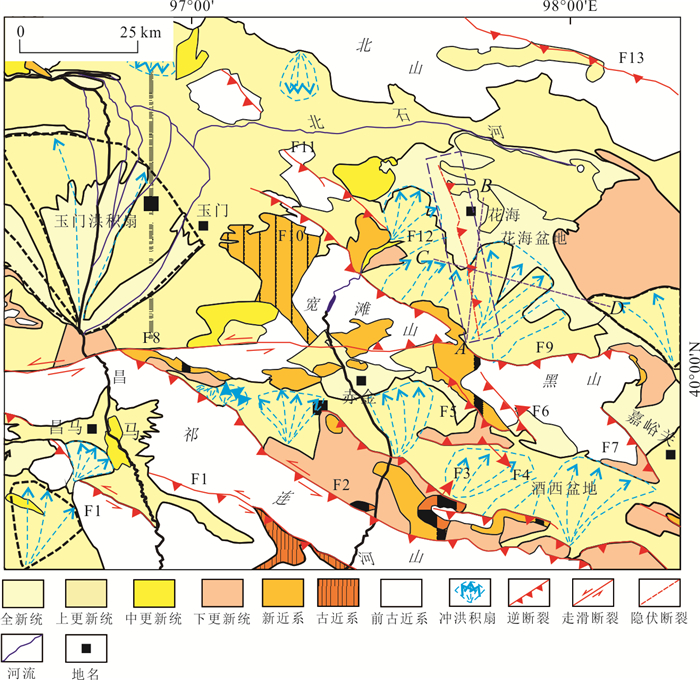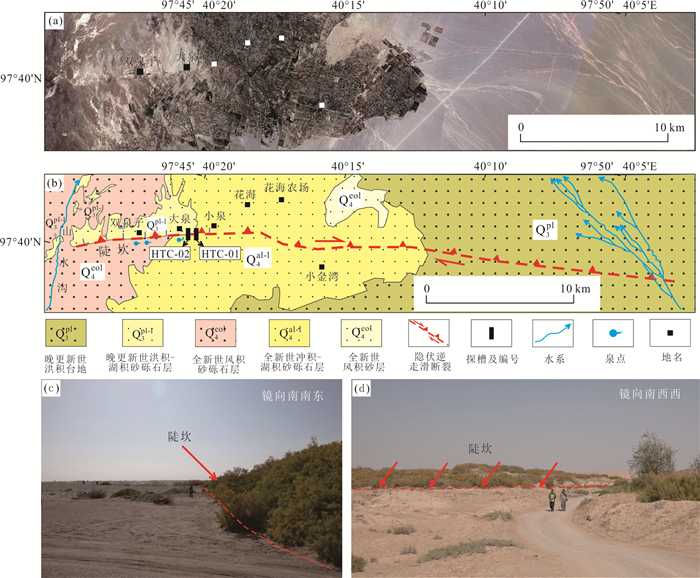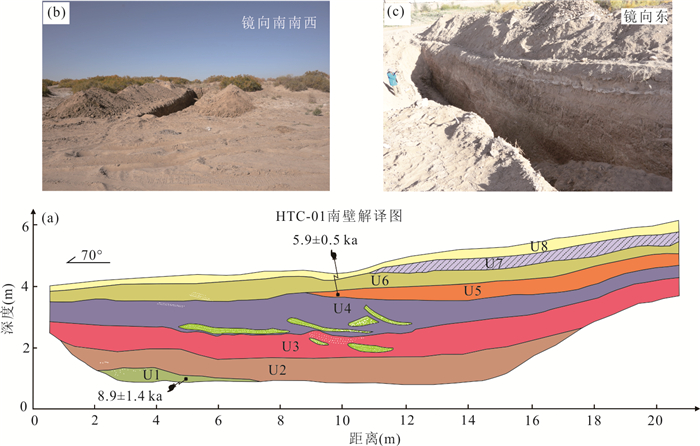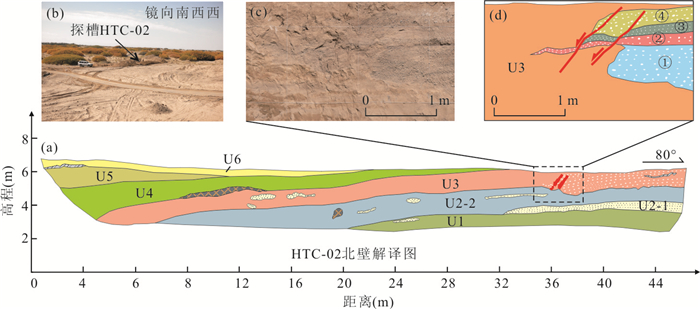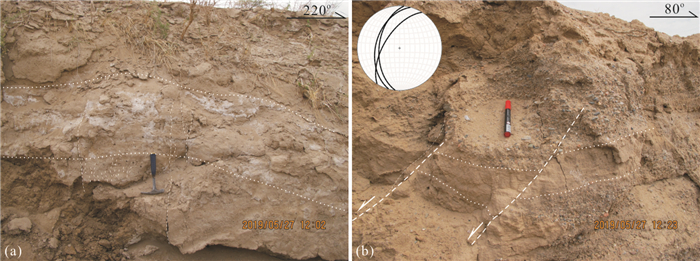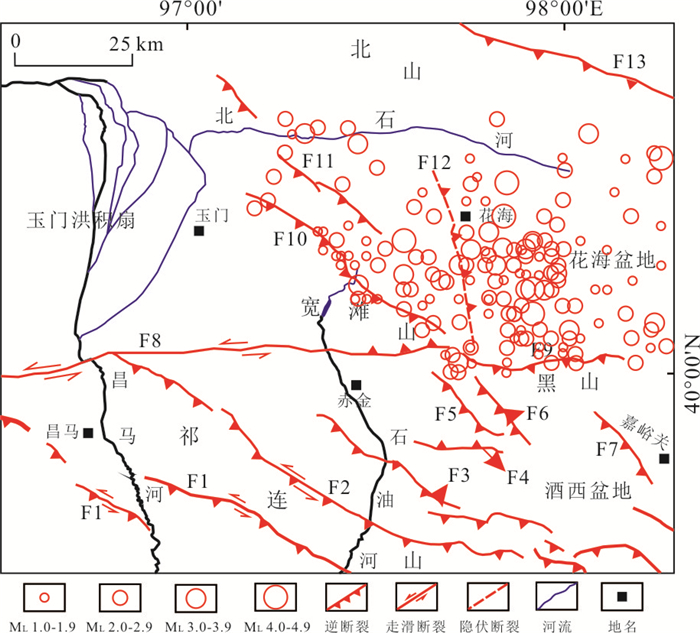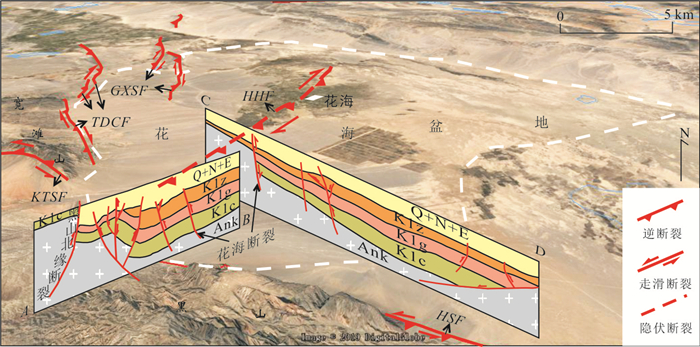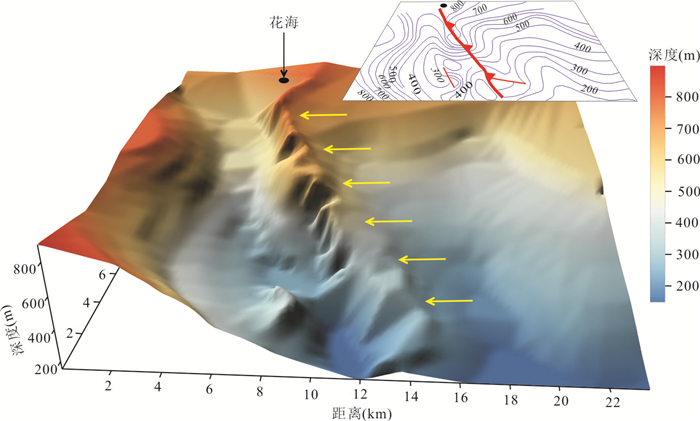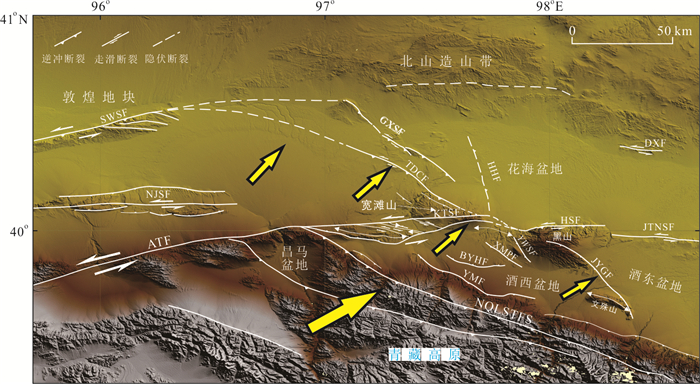Geometry, Kinematics and Regional Tectonic Significance of the Huahai Fault in the Western Hexi Corridor, NW China
-
摘要: 花海断裂位于河西走廊西段花海盆地内,总体走向NNW-SSE,长约38 km,为一条隐伏断裂,研究其空间展布、运动性质和活动历史对于理解青藏高原北缘的构造变形和扩展方式有重要意义.基于卫片解译、野外实地和槽探,结合光释光测年和地球物理资料,发现沿双泉子、大泉至小泉一带,发育一段长约8 km的地形陡坎,代表断裂控制下褶皱作用的地形表现.沿陡坎走向向南,断裂一直隐伏延伸至宽滩山和黑山以北.现有资料分析表明,断裂经历了早白垩世的正断、晚白垩的逆冲运动.新生代以来,断裂继承了之前的逆冲运动并一直持续至全新世中晚期.高原北缘的侧向扩展,使得作为三危山与阿尔金断裂之间块体边界的三危山、干峡山、宽滩山和塔尔湾-登登山-池家刺窝断裂发生以左旋走滑为主兼有逆冲的变形,导致了边界断裂控制山体的隆升,而内部的块体受压剪作用向北东运动.花海断裂的逆冲运动即是该次构造活动事件的响应.Abstract: The NNW-SSE striking Huahai fault develops in the Huahai Basin in the western Hexi corridor. Its spatial distribution, kinematics and activity are significance for understanding the tectonic deformation and outgrowth of the northern margin of the Qinghai-Tibet Plateau. Based on the interpretation of satellite images, field surveying, trenching, optical luminescence dating and existing geophysical data, the characteristics of Huahai fault are reported. A landform scarp develops along the Huahai fault, which is approximate 8 km long from Shuangquanzi, Daquan to Xiaoquan. This scarp is caused by the fault related folding. The fault extends southward to the northern Kuantanshan and Heishan ranges indicated by scarps, springs and landforms. The Huahai fault was once a normal fault in the Early Cretaceous, and was inversed to be a thrust fault in the Late Cretaceous. During the Cenozoic, the northward growth of the Qinghai-Tibetan Plateau resulted in development of a series of sinistrally transpressive faults such as the Sanweishan, Ganxiashan, Kuantanshan and Taerwan-Dengdengshan-Chijiaoziwo faults. These faults are boundaries of blocks between the Sanweishan and Altyn Tagh faults, and cause the uplift of the mountain ranges along faults, and the northeastward movement of blocks among faults. The thrusting of the Huahai fault is the response of this recent tectonic event.
-
Key words:
- Qinghai-Tibetan Plateau /
- western Hexi corridor /
- Huahai fault /
- Cenozoic /
- activity history /
- tectonics
-
图 2 河西走廊西段新构造图
F1.昌马断裂;F2.祁连山北缘断裂;F3.玉门断裂;F4.白杨河断裂;F5.新民堡断裂;F6.阴洼山断裂;F7.嘉峪关-文殊山断裂;F8.阿尔金断裂(宽滩山段);F9.黑山断裂;F10.塔尔湾-登登山-池家刺窝断裂;F11.干峡山断裂;F12花海断裂;F13.红旗山断裂;深蓝色虚线指示图 4中地震剖面位置,蓝色方框指示花海断裂位置
Fig. 2. Neotectonics map in western Hexi corridor
图 8 花海断裂空间展布与延伸
白色虚线圈定花海盆地范围,HHF:花海断裂;TDCF:塔尔湾-登登山-池家刺窝断裂;GXSF.干峡山断裂;KTSF.宽滩山断裂;HSF.黑山断裂;AB和CD.深部地震剖面,位置见图 2;Ank.前白垩系;K1c.下白垩统赤金堡组;K1g.下白垩统下沟组;K1z.下白垩统中沟组;E.古近系;N.新近系;Q.第四系
Fig. 8. Space distribution and extension of Huahai fault
图 9 穿越花海断裂地震剖面
Ank.前白垩系;K1c.下白垩统赤金堡组;K1g.下白垩统下沟组;K1z.下白垩统中沟组;E.古近系;N.新近系;Q.第四系;M和N.方框范围内原始剖面;①②③对应不同的活动时期; AB剖面.据覃素华等(2013)修改;CD剖面.据李明杰(2006);修改剖面位置见图 1
Fig. 9. Seismic interpretation profile cross the Huahai fault
图 10 花海盆地中新统底界三维图
黄色箭头指示断裂位置;原始资料据李庆山等(1994)
Fig. 10. 3D map of the Miocene bottom boundary in the Huahai basin
图 11 青藏高原北缘构造变形模式图
NQLSTFS.北祁连逆冲断裂系;YMF.玉门断裂;BYHF.白杨河断裂;XMPF.新民堡断裂;YWSF.阴洼山断裂;JYGF.嘉峪关断裂;JTNSF.金塔南山北缘断裂;TDCF.塔尔湾.登登山.池家刺窝断裂;GXSF.干峡山断裂;HHF.花海断裂;DXF.鼎新断裂;ATF.阿尔金断裂;NJSF.南截山断裂;SWSF.三危山断裂;黄色箭头指示GPS速度场方向;参考李煜航等(2015)
Fig. 11. Tectonic deformation model of the northern margin of the Tibet
表 1 研究区内新生代地层主要特征
Table 1. Description and era of the Cenozoic strata in the study area
地层名称 地层描述 地层时代 资料来源 火烧沟组(Eh) 该组厚250~1 000 m,与下覆地层呈平行不整合或角度不整合接触,由棕红色、灰白色泥岩、砂岩组成. 40.2~33.4 Ma 戴霜等(2005) 白杨河组(Nb) 该层在河西走廊内部广泛发育,呈南厚北薄,厚454~929 m,在盆地内与下覆火烧沟组分别呈平行和角度不整合接触,为桔红色、棕红色砂岩、泥岩及互层. 24.2~16.7 Ma Wang et al.(2016) 疏勒河组(Ns) 该层广泛分布于酒西盆地,南厚北薄,与白杨河组呈平行不整合接触,岩性为土黄色、棕黄色泥岩、砂岩和砾岩. 16.0~4.5 Ma 赵志军等(2001);方小敏等(2004) 玉门砾岩组(Qp1) 该层为一套砾岩、砂砾岩夹砂岩透镜体内含少量巨砾或岩块漂砾沉积,与下覆疏勒河组或老地层呈不整合接触. 底界年龄3.45~5.23 Ma,顶界年龄在0.9 Ma左右 史正涛等(2001);刘栋梁等(2012) 酒泉砾石组(Qp2) 该层为一套冲洪积冲洪积砂砾及亚砂土、亚黏土,厚数十米至百余米 0.84~0.14 Ma 方小敏等(2004);刘栋梁等(2012) 戈壁砾石组(Qp3~Qh) 该层为冲洪积砂砾及亚沙土,砂碎石及黄土状亚沙土、亚黏土,厚十余米 0.14~0 Ma 方小敏等(2004) 表 2 光释光样品测年结果
Table 2. Dating results of OSL samples
野外编号 埋深(m) 环境剂量率(Ga/ka) 等效剂量(Ga) 年龄(ka) OSL-2 1.0 3.5±0.4 20.5±2.0 5.9±0.5 OSL-5 4.5 3.3±0.3 29.5±4.3 8.9±1.4 -
Burchfiel, B.C., 2012. Tectonics of the Southeastern Tibetan Plateau and Its Adjacent Foreland. Memoir of the Geological Society of America, 210:1-164. http://www.researchgate.net/publication/279770011_Tectonics_of_the_southeastern_Tibetan_Plateau_and_its_adjacent_foreland Chen, B.L., 2006. The Activity of the Xinminbao Fault from the Late Pleistocene to Holocene. Acta Geoscientica Sinica, 27(6):515-524 (in Chinese with English abstract). http://www.oalib.com/paper/1557720 Chen, B.L., Wang, C.Y., Gong, Y.L., 2008. Late Cenozoic Activity of the Yumen Fault in the Western Segment of the Hexi Corridor, NW China. Geological Bulletin of China, 27(10):1709-1719 (in Chinese with English abstract). http://d.wanfangdata.com.cn/Periodical/zgqydz200810013 Chen, T., Liu Y.G., Min, W., et al., 2012. The Activity age of Taerwan Fault and Genesis of the Topographic Scarp. Seismology and Geology, 34(3):401-414 (in Chinese with English abstract). http://www.en.cnki.com.cn/Article_en/CJFDTOTAL-DZDZ201203005.htm Chen, W.B., Xu, X.W., 2006. Sinistral Strike-slip Faults Along the Southern Alashan Margin and Eastwards Extending of the Altun Fault. Seismology and Geology, 28(2):319-324 (in Chinese with English abstract). Cunningham, D., Zhang, J., Li, Y. F., 2016. Late Cenozoic Transpressional Mountain Building Directly North of the Altyn Tagh Fault in the Sanweishan and Nanjieshan, North Tibetan Foreland, China. Tectonophysics, 687:111-128. https://doi.org/10.1016/j.tecto.2016.09.010 Dai, S., Fang, X.M., Song, C.H., et al., 2005. Early Uplift of the Northern Tibetan Plateau. Chinese Science Bulletin, 50(7):673-683 (in Chinese). doi: 10.1360/csb2005-50-7-673 Elliott, J. R., Biggs, J., Parsons, B., et al., 2008. InSAR Slip Rate Determination on the Altyn Tagh Fault, Northern Tibet, in the Presence of Topographically Correlated Atmospheric Delays. Geophysical Research Letters, 35(12)::82-90. https://doi.org/10.1029/2008gl033659 England, P., Houseman, G., 1986. Finite Strain Calculations of Continental Deformation:2. Comparison with the India-Asia Collision Zone. Journal of Geophysical Research:Solid Earth, 91(B3):3664-3676. https://doi.org/10.1029/jb091ib03p03664 Fang, X.M., Zhao, Z.J., Li, J.J., et al., 2004. Magneto Stratigraphy of the Late Cenozoic Laojunmiao Anticline in the Northern Qilian Mountains and Its Implications for the Northern Tibetan Plateau Uplift. Science in China:Series D, Earth Sciences, 34(2):97-106 (in Chinese). Guo, C.H., Li, A., Liu R., 2018. A Preliminary Research on the Right-Lateral Strike-Slip Characteristics and the Structural Significance of the Northern Kantanshan Faults, Hexi Corridor, Based on High-Resolution Imagery. Seismology and Geology, 40(4):69-85(in Chinese with English abstract). http://en.cnki.com.cn/Article_en/CJFDTotal-DZDZ201804006.htm Guo, Z.J., Zhang, Z.C., Zhang, C., et al., 2008. Lateral Growth of the Altyn Tagh Strike-Slip Fault at the North Margin of the Qinghai-Tibet Plateau:Late Cenozoic Strike-Slip Faults and the Crustal Stability in the Beishan Area, Gansu, China. Geological Bulletin of China, 27(10):1678-1686 (in Chinese with English abstract). http://www.zhangqiaokeyan.com/academic-journal-cn_geological-bulletin-china_thesis/0201252287889.html Hu, Q.X., Wang, X.Y., Meng, X.Q., et al., 2018. Paleoclimatic Implications of Oxygen Isotope from Authigenic Carbonates in Loess Deposit of Northeastern Tibetan Plateau. Earth Science, 43(11):4128-4137(in Chinese with English abstract). http://www.researchgate.net/publication/330192348_Paleoclimatic_Implications_of_Oxygen_Isotope_from_Authigenic_Carbonates_in_Loess_Deposit_of_Northeastern_Tibetan_Plateau Jin, S., Sheng, Y., Liang, H.D., et al., 2019. Lithospheric Electrical Structure along Shenzha-Shuanghu Profile in Tibetan Plateau and Its Significance. Earth Science, 44(6):1773-1783(in Chinese with English abstract). http://en.cnki.com.cn/Article_en/CJFDTotal-DQKX201906002.htm Lamb, M. A., Hanson, A. D., Graham, S. A., et al., 1999. Left-Lateral Sense Offset of Upper Proterozoic to Paleozoic Features Across the Gobi Onon, Tost, and Zuunbayan Faults in Southern Mongolia and Implications for other Central Asian Faults. Earth and Planetary Science Letters, 173(3):183-194. https://doi.org/10.1016/s0012-821x(99)00227-7 Li, J.J., Fang, X.M., Pan, B.T., et al., 2001. Late Cenozoic Intensive Uplift of Qinghai-Xizang Plateau and Its Impacts on Environments in Surrounding Area. Quaternary Sciences. 21(5):381-391 (in Chinese with English abstract). Li, J.M., 2006. Structure Character and Petroleum Exploration of Jiuquan Basin(Dissertation). China University of Geosciences, Beijing(in Chinese with English abstract). Li, Q.S., 1994. Distribution and Active Characteristics of the Huahai Fault. Crustal Structure and Crustal Stress Proceedings, Beijing, 45-51(in Chinese with English abstract). Li, Y.H., Wang, Q.L., Cui, D.X., 2015. Inversion of Present-Day Fault Slip Rate Along Altyn Tagh Fault Constrained by GPS Data. Seismology and Geology, 37(3):869-879 (in Chinese with English abstract). http://www.en.cnki.com.cn/Article_en/CJFDTotal-DZDZ201503016.htm Li, A., Wang X.X., Zhang S.M., et al., 2016. The Slip Rate and Paleoearthquakes of the Yumen Fault in the Northern Qilian Mountains since the Late Pleistocene. Seismology and Geology, 38(4):897-910 (in Chinese with English abstract). http://en.cnki.com.cn/Article_en/CJFDTOTAL-DZDZ201604008.htm Liu, D.L., Song, C.H., Fang, X.M., 2012. Magnetostratigraphy of Yumen Conglomerate in the Yunmushan Region and Its Implication for Deformation and Uplift of the NE Tibetan Plateau. Acta Geological Sinica, 86(6):898-905(in Chinese with English abstract). http://www.cqvip.com/QK/95080X/201206/42212469.html Ma, J., 1999. Changing Viewpoint from Fault to Block:A Discussion about the Role of Active Block in Seismicity. Earth Science Frontiers, 6(4):363-370 (in Chinese with English abstract). http://en.cnki.com.cn/Article_en/CJFDTOTAL-DXQY199904029.htm Meyer, B., Tapponnier, P., Gaudemer, Y., et al., 1996. Rate of Left-Lateral Movement along the Easternmost Segment of the Altyn Tagh Fault, East of 96°E (China). Geophysical Journal International, 124(1):29-44. https://doi.org/10.1111/j.1365-246x.1996.tb06350.x Min, W., Liu, Y.G., Chen, T., et al., 2016. The Quantitate Study on Activity of Dengengshan-Chijiaciwo Fault since Late Quaternary. Seismology and Geology, 38(3):503-522 (in Chinese with English abstract). http://www.en.cnki.com.cn/Article_en/CJFDTotal-DZDZ201603002.htm Molnar, P., Tapponnier, P., 1975. Cenozoic Tectonics of Asia:Effects of a Continental Collision:Features of Recent Continental Tectonics in Asia can be Interpreted as Results of the India-Eurasia Collision. Science, 189(4201):419-426. https://doi.org/10.1126/science.189.4201.419 Qin, S.H., Wang, X.S., Kang, N.C., et al., 2013. An Analysis of the Effect from Altyn Tagh Fault upon Jiuquan Basin. Acta Petrologic Sinica, 29(8):2895-2905 (in Chinese with English abstract). Shi, Z.T., Ye, S.G., Zhao, Z.J., et al., 2001. ESR Age of Late Cenozoic Stratigraphy in Jiuxi Basin. Science in China, Ser. D Earth Science, 2001(S1):163-168 (in Chinese). Stirling, M., Goded, T., Berryman, K., et al., 2013. Selection of Earthquake Scaling Relationships for Seismic-Hazard Analysis. Bulletin of the Seismological Society of America, 103(6):2993-3011. https://doi.org/10.1785/0120130052 Wang, W.T., Zhang, P.Z., Pang, J.Z., 2016. The Cenozoic Growth of the Qilian Shan in the Northeastern Tibetan Plateau:A Sedimentary Archive from the Jiuxi Basin. Journal of Geophysical Research:Solid Earth, 121(4):2235-2257. https://doi.org/10.1002/2015jb012689 Webb, L. E., Johnson, C. L., Minjin, C., 2010. Late Triassic Sinistral Shear in the East Gobi Fault Zone, Mongolia. Tectonophysics, 495(3/4):246-255. https://doi.org/10.1016/j.tecto.2010.09.033 Wells, D.L., Coppersmith K.J., 1994. New Empirical Relationships among Magnitude, Rupture Length, Rupture Width, Rupture Area, and Surface Displacement. Bulletin of the Seismological Society of America, 84(4):974-1002. http://gji.oxfordjournals.org/cgi/ijlink?linkType=ABST&journalCode=ssabull&resid=84/4/974 Xu, X.W., Tapponnier, P., Woerd V.D., 2005. Late Quaternary Sinistral Slip Rate along the Altyn Tagh Fault and Its Structural Transformation Model. Science in China, Ser. D Earth Sciences, 8(3):384-397. http://d.wanfangdata.com.cn/Periodical_zgkx-ed200503010.aspx Yu, Z.Y., Min, W., Chen, T., 2015. Late Quaternary Tectonic Deformation of the Eastern End of the Altyn Tagh Fault. Acta Geologica Sinica-English Edition, 89(6):1813-1834. https://doi.org/10.1111/1755-6724.12599 Yue, Y. J., Graham, S. A., Ritts, B. D., et al., 2005. Detrital Zircon Provenance Evidence for Large-Scale Extrusion along the Altyn Tagh Fault. Tectonophysics, 406(3/4):165-178. https://doi.org/10.1016/j.tecto.2005.05.023 Yun, L., Zhang J., Xiao, Q.B., et al., 2019. The Thrust Movement and Deep Structural Characteristic of the Sanweishan Fault in the Northern Margin of the Tibetan Plateau since the Late Quaternary. Acta Geological Sinica, 93(9):2107-2122 (in Chinese with English abstract). http://en.cnki.com.cn/Article_en/CJFDTotal-DZXE201909001.htm Zhang, N., Zheng, W.J., Liu, X.W., et al., 2016. Kinematics Characteristics of Heishan Fault in the Western Hexi Corridor and Its Implications for Regional Tectonic Transformation. Journal of Earth Sciences and Environment, 38(02):245-257 (in Chinese with English abstract). http://en.cnki.com.cn/Article_en/CJFDTotal-XAGX201602010.htm Zhao, Z.J., Fang, X.M., Li, J.J. 2001. Late Cenozoic Magnetic Strata in Jiudong Basin, Northern Margin of Qilian Mountains. Science in China, Ser. D Earth Science, 31:195-201 (in Chinese). doi: 10.1007/BF02911993 Zheng, W. J., Zhang, P. Z., Ge, W. P., et al., 2013. Late Quaternary Slip Rate of the South Heli Shan Fault (Northern Hexi Corridor, NW China) and Its Implications for Northeastward Growth of the Tibetan Plateau. Tectonics, 32(2):271-293. https://doi.org/10.1002/tect.20022 Zhu, L.D., Wang, C.S., Zheng, R. C., et al., 2005. Evolutionary Characteristics of the Jiuquan Basin and Character of the Kuantaishan-Heishan Fault on the Northeastern Margin of the Qinghai-Tibet Plateau. Geological Bulletin of China, 24(9):837-840 (in Chinese with English abstract). http://en.cnki.com.cn/Article_en/CJFDTOTAL-ZQYD200509009.htm 陈柏林, 2006.新民堡断裂新构造活动特征.地球学报, 27(6):515-524. doi: 10.3321/j.issn:1006-3021.2006.06.001 陈柏林, 王春宇, 宫玉良, 2008.河西走廊盆地西段玉门断裂晚新生代的活动特征.地质通报, 27(10):1709-1719 doi: 10.3969/j.issn.1671-2552.2008.10.013 陈涛, 刘玉刚, 闵伟, 等, 2012.塔尔湾断裂活动时代厘定及地貌陡坎成因分析.地震地质, 34(3):401-414. doi: 10.3969/j.issn.0253-4967.2012.03.002 陈文彬, 徐锡伟, 2006.阿拉善地块南缘的左旋走滑断裂与阿尔金断裂带的东延.地震地质, 28(2):319-324. doi: 10.3969/j.issn.0253-4967.2006.02.015 戴霜, 方小敏, 宋春晖, 等, 2005.青藏高原北部的早期隆升.科学通报, 50(7):673-683. doi: 10.3321/j.issn:0023-074X.2005.07.011 方小敏, 赵志军, 李吉均, 等, 2004.祁连山北缘老君庙背斜晚新生代磁性地层与高原北部隆升.中国科学D辑:地球科学, 34(2):97-106 https://www.cnki.com.cn/Article/CJFDTOTAL-JDXK200402000.htm 郭长辉, 李安, 刘睿, 等, 2018.基于高分辨率影像的宽滩山北缘断裂带右旋走滑特征及其构造意义的初步研究.地震地质, 40(4):69-85. https://www.cnki.com.cn/Article/CJFDTOTAL-DZDZ201804006.htm 郭召杰, 张志诚, 张臣, 等, 2008.青藏高原北缘阿尔金走滑边界的侧向扩展——甘肃北山晚新生代走滑构造与地壳稳定性分析.地质通报, 27(10):1678-1686. doi: 10.3969/j.issn.1671-2552.2008.10.010 胡泉旭, 王先彦, 孟先强, 等, 2018.青藏高原东北部黄土次生碳酸盐氧同位素的古气候意义.地球科学, 43(11):4128-4137 doi: 10.3799/dqkx.2018.228 金胜, 盛跃, 梁宏达, 等, 2019.青藏高原申扎-双湖剖面岩石圈电性结构特征及其含义.地球科学, 44(6): 1773-1783 doi: 10.3799/dqkx.2019.015 李安, 王晓先, 张世民, 等, 2016.祁连山北缘玉门断裂晚更新世以来的活动速率及古地震.地震地质, 38(4):897-910 doi: 10.3969/j.issn.0253-4967.2016.04.008 李吉均, 方小敏, 潘保田, 等, 2001.新生代晚期青藏高原强烈隆起及其对周边环境的影响第四纪研究. 21(5):381-391 doi: 10.3321/j.issn:1001-7410.2001.05.001 李明杰, 2006.酒泉盆地构造特征与油气勘探(博士毕业论文).北京: 中国地质大学. 李庆山, 1994.花海断裂几何展布及新活动特征.地壳构造与地壳应力文集, 北京, 45-51 https://www.cnki.com.cn/Article/CJFDTOTAL-SEIS199400005.htm 李煜航, 王庆良, 崔笃信, 等, 2015.利用GPS数据反演阿尔金断裂现今滑动速率.地震地质, 37(3):869-879 doi: 10.3969/j.issn.0253-4967.2015.03.016 马瑾, 1999.从断层中心论向块体中心论转变——论活动块体在地震中的作用, 地学前缘, 6(4):363-370 doi: 10.3321/j.issn:1005-2321.1999.04.020 刘栋梁, 宋春晖, 方小敏, 等, 2012.榆木山地区玉门砾岩磁性地层及其对青藏高原东北部变形隆升意义.地质学报, 86(6):898-905. doi: 10.3969/j.issn.0001-5717.2012.06.005 闵伟, 刘玉刚, 陈涛, 等, 2016.登登山-池家刺窝断裂晚第四纪活动性定量研究.地震地质, 38(3):503-522 doi: 10.3969/j.issn.0253-4967.2016.03.002 史正涛, 业渝光, 赵志军, 等, 2001.酒西盆地晚新生代地层的ESR年代.中国科学D辑:地球科学, 2001(S1):163-168. https://www.cnki.com.cn/Article/CJFDTOTAL-JDXK2001S1024.htm 覃素华, 王小善, 康南昌, 等, 2013.阿尔金断裂对酒泉盆地的控制作用分析.岩石学报, 29(8):2985-2905 https://www.cnki.com.cn/Article/CJFDTOTAL-YSXB201308025.htm 云龙, 张进, 肖骑斌, 等, 2019.青藏高原北缘三危山断裂晚第四纪以来的逆冲运动及其深部构造特征.地质学报, 93(9):2107-2122. doi: 10.3969/j.issn.0001-5717.2019.09.001 张宁, 郑文俊, 刘兴旺, 等, 2016.河西走廊西端黑山断裂运动学特征及其在构造转换中的意义.地球科学与环境学报, 38(2):245-257. doi: 10.3969/j.issn.1672-6561.2016.02.012 朱利东, 王成善, 郑荣才, 等, 2005.青藏高原东北缘酒泉盆地的演化特征与宽台山-黑山断裂的性质.地质通报, 24(9):837-840. doi: 10.3969/j.issn.1671-2552.2005.09.009 赵志军, 方小敏, 李吉均, 2001.祁连山北缘酒东盆地晚新生代磁性地层.中国科学D辑:地球科学, 31:195-201. https://www.cnki.com.cn/Article/CJFDTOTAL-JDXK2001S1029.htm -









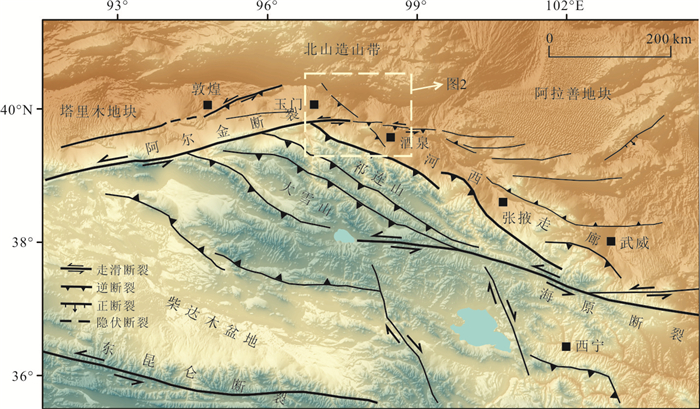
 下载:
下载:
